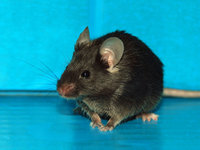Strain Data Sheet
RBRC02142
Strain Information | |
|---|---|
| Image |  |
| BRC No. | RBRC02142 |
| Type | Targeted Mutation Congenic |
| Species | Mus musculus |
| Strain name | B6.129S2-Pdcd1<tm1Hon>/HonRbrc |
| Former Common name | C57BL/6-PD-1KO, C57BL/6-Pdcd1-/- mouse |
| H-2 Haplotype | |
| ES Cell line | D3 [129S2/SvPas] |
| Background strain | C57BL/6 |
| Appearance | black [(a/a B/B C/C)] |
| Strain development | Developed by Tasuku Honjo, Graduate School of Medicine, Kyoto University in 1998. The knockout construct was electoroporated into D3 ES cells derived from 129S2/SvPas. The mutant mice were backcrossed to C57BL/6 over 11 generations. |
| Strain description | PD1 knockout mice. EcoRV site of exon 3 to PvuII site of exon 5 was replaced with noemycin selection cassette. PD1 (Pdcd1, programmed cell death 1) gene is an immunoinhibitory receptor that belongs to the CD28 family, plays a role in the negative control of proliferation, differentiation and class switching of B cells. PD1 deficiency has been shown to develop different forms of autoimmune diseases on different backgrounds of mice. Homozygous PD1 mutant mice of C57BL/6 background show moderate but consistent splenomegaly, and spontaneously develop characteristic lupus-like proliferative arthritis and golmerulonephritis with the age. |
| Colony maintenance | Homozygote x Homozygote. |
| References | Immunological studies on PD-1 deficient mice: implication of PD-1 as a negative regulator for B cell responses. Nishimura H, Minato N, Nakano T, Honjo T Int. Immunol.,10,1563-1572 (1998). 9796923Development of lupus-like autoimmune diseases by disruption of the PD-1 gene encoding an ITIM motif-carrying immunoreceptor. Nishimura H, Nose M, Hiai H, Minato N, Honjo T Immunity, 11, 141-151 (1999). 10485649Autoimmune dilated cardiomyopathy in PD-1 receptor-deficient mice. Nishimura H, Okazaki T, Tanaka Y, Nakatani K, Hara M, Matsumori A, Sasayama S, Mizoguchi A, Hiai H, Minato N, Honjo T Science, 291, 319-322 (2001). 11209085 |
Health Report | |
|---|---|
| Examination Date / Room / Rack | 2025/06/09Room:3-3Rack:ASentinel mouse program 2025/03/10Room:3-3Rack:ASentinel mouse program 2024/12/09Room:3-3Rack:ASentinel mouse program 2024/09/09Room:3-3Rack:ASentinel mouse program 2024/06/10Room:3-3Rack:ASentinel mouse program 2024/03/11Room:3-3Rack:ASentinel mouse program 2023/12/11Room:3-3Rack:ASentinel mouse program 2023/09/11Room:3-3Rack:ASentinel mouse program |
Gene | |||||||
|---|---|---|---|---|---|---|---|
| Gene Symbol | Gene Name | Chr. | Allele Symbol | Allele Name | Common Names | Promoter | Diseases Related to This Gene |
| Pdcd1 MGI:104879 | programmed cell death 1 | 1 | Pdcd1<tm1Hon> MGI:2386184 | targeted mutation 1, Tasuku Honjo | |||
| neo | neomycin resistance gene (E. coli) | 1 | mouse phosphoglycerate kinase promoter (PGK promoter) | ||||
Phenotype | |
|---|---|
| Phenotype annotation from literatures by Mammalian phenotype ontology | more 29 phenotypes |
| Detailed phenotype data | |
Ordering Information | |
|---|---|
| Donor DNA | mouse phosphoglycerate kinase promoter (PGK promoter), E. coli neo, mouse PD-1(immunoglobulin superfamily member) genomic DNA |
| Research application | Immunology and Inflammation Research |
| Specific Term and Conditions | 1) The RECIPIENT shall use the BIOLOGICAL RESOURCE only for academic research for the purpose of publishing the research results. 2) In publishing the research results obtained by use of the BIOLOGICAL RESOURCE, an acknowledgment to the DEPOSITOR and a citation of the following literature(s) designated by the DEPOSITOR are requested. Science 291, 319-322 (2001). 3) RECIPIENT shall notify the PROVIDER upon filing a patent application claiming modification of the BIOLOGICAL RESOURCE or method(s) of manufacture or use(s) of the BIOLOGICAL RESOURCE. |
| Depositor | Tasuku Honjo (Kyoto University) |
| Strain Status |  Live mice Live mice Frozen embryos Frozen embryos Frozen sperm Frozen sperm |
| Strain Availability | Cryopreserved sperm (within 1 month) Cryopreserved embryos (within 1 month) Live mouse (1 to 3 months) |
| Additional Info. | Necessary documents for ordering:
Genotyping protocol -PCR- Mouse of the Month Jul 2012 |
BRC mice in Publications |
|---|
Akama Y, Park EJ, Satoh-Takayama N, Ito A, Kawamoto E, Gaowa A, Matsuo E, Oikawa S, Saito M, Inoue S, Akimoto T, Suzuki K, Shimaoka M. Roles of programmed death-1 and muscle innate lymphoid cell-derived interleukin 13 in sepsis-induced intensive care unit-acquired weakness. J Cachexia Sarcopenia Muscle (2024) 39016179 |
Gao Y, Song B, Aoki S, Ito K. Conjugation of human serum albumin and flucloxacillin provokes specific immune response in HLA-B*57:01 transgenic mice. Immunol Lett 249 5-11(2022) 35963284 |
Miyajima M, Zhang B, Sugiura Y, Sonomura K, Guerrini MM, Tsutsui Y, Maruya M, Vogelzang A, Chamoto K, Honda K, Hikida T, Ito S, Qin H, Sanuki R, Suzuki K, Furukawa T, Ishihama Y, Matsuda F, Suematsu M, Honjo T, Fagarasan S. Metabolic shift induced by systemic activation of T cells in PD-1-deficient mice perturbs brain monoamines and emotional behavior. Nat Immunol 18(12) 1342-1352(2017) 29058703 |
Horne-Debets JM, Faleiro R, Karunarathne DS, Liu XQ, Lineburg KE, Poh CM, Grotenbreg GM, Hill GR, MacDonald KP, Good MF, Renia L, Ahmed R, Sharpe AH, Wykes MN. PD-1 dependent exhaustion of CD8+ T cells drives chronic malaria. Cell Rep 5(5) 1204-13(2013) 24316071 |
Yokosuka T, Takamatsu M, Kobayashi-Imanishi W, Hashimoto-Tane A, Azuma M, Saito T. Programmed cell death 1 forms negative costimulatory microclusters that directly inhibit T cell receptor signaling by recruiting phosphatase SHP2. J Exp Med 209(6) 1201-17(2012) 22641383 |
Kawamoto S, Tran TH, Maruya M, Suzuki K, Doi Y, Tsutsui Y, Kato LM, Fagarasan S. The inhibitory receptor PD-1 regulates IgA selection and bacterial composition in the gut. Science 336(6080) 485-9(2012) 22539724 |
Mumprecht S, Schürch C, Schwaller J, Solenthaler M, Ochsenbein AF. Programmed death 1 signaling on chronic myeloid leukemia-specific T cells results in T-cell exhaustion and disease progression. Blood 114(8) 1528-36(2009) 19420358 |